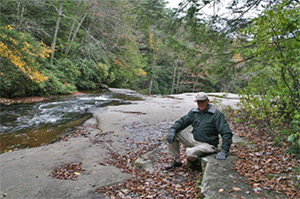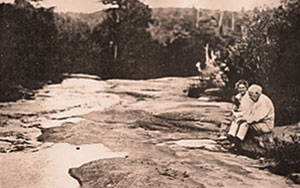 Thomas Edison and his wife, Mina Miller Edison, share a few contemplative moments along Muddy Creek upstream from the falls. Thomas Edison, Harvey Firestone, and Henry Ford, who called themselves the Vagabonds, camped near the falls with their families for almost a week in late July, 1921. Historians have stated that the Vagabonds’ two-week summer outings between the years 1915 and 1924 were the first linking of the automobile with outdoor recreation.
Thomas Edison and his wife, Mina Miller Edison, share a few contemplative moments along Muddy Creek upstream from the falls. Thomas Edison, Harvey Firestone, and Henry Ford, who called themselves the Vagabonds, camped near the falls with their families for almost a week in late July, 1921. Historians have stated that the Vagabonds’ two-week summer outings between the years 1915 and 1924 were the first linking of the automobile with outdoor recreation.
Newspapers across the country reported on the Vagabonds’ camping trips and the public read these accounts with great interest. These stories in part created a desire in America to explore and discover the great outdoors in their automobiles just like the Vagabonds. This demand created a new multi-million dollar outdoor recreation industry. Their camping trips also helped gain public support for acquisition of additional land for public use that became our national and state park and forest systems that we enjoy today.
The Vagabonds’ 1921 camping trip to western Maryland was unique as it was the first time these industrial giants brought with them their wives and families. Thomas Edison’s accomplishments as a business entrepreneur are well known, but his wife Mina also was a woman of significant achievements that helped to protect and conserve our natural resources.
Mina’s father, Lewis Miller, played a large role in establishing Chautauqua, located in upper western New York State. This organization fostered life-long learning in a natural outdoor setting to help rejuvenate and enhance the mind and spirit.
Mina, a conservationist in her own right, was very concerned with the urbanization of the east coast and the loss of natural, rustic habitats. Conservationists such as nature writer John Burroughs, who also was a Vagabond, had a huge impact on Mina’s thinking. Mina’s influence and input in the early years helped to establish our National Park System.
Did you know? Henry Ford founded Kingsford Charcoal Company. The charcoal plant he established in his company town of Kingsford, Michigan was fully up and running by 1921, the same year he camped with Edison and Firestone at Muddy Creek in present Swallow Falls State Park. Ford owned a sawmill in northern Michigan that produced lumber he needed to make his automobiles.

Ford, ever the creative entrepreneur, developed a manufacturing process to turn wood scraps from the sawmill into a commercial product…charcoal! Ford learned how to produce charcoal briquettes economically that were useful in the grilling of food. He made this popular product by charring a mix of softwoods like pine and spruce, then grounding the charcoal and mixing it with an adhesive. These small dark squares of charcoal that are used by countless outdoor grillers burn with more heat and produce less smoke than wood.
Perhaps just out of view of this photograph of Thomas and Mina Edison at Swallow Falls, Henry Ford and his staff are grilling supper using one of his newest products, Kingsford charcoal.
GPS Wayside Point:
N 39 04 04.1
W 79 25 03.2
Photographs (top to bottom):
- Photograph of Offutt Johnson relaxing on the Edison sitting/thinking stone in the Fall of 2012 at Swallow Falls State Park.
- Thomas Edison and his wife, Mina Miller Edison, share a few contemplative moments along Muddy Creek upstream from the falls.
Acknowledgements:
Maryland State Forests and State Parks
Significant Monuments and Landmarks In Garrett County, Maryland
By Offutt Johnson and Champ Zumbrun
July 11, 2013
Back to Feature Stories